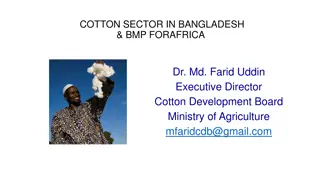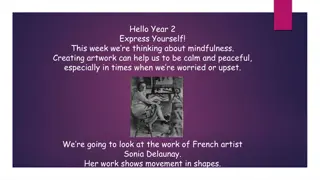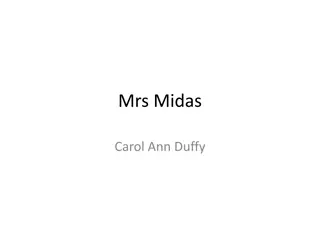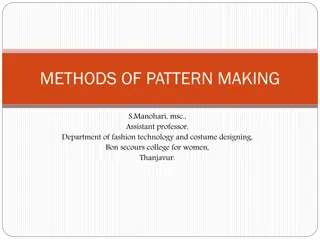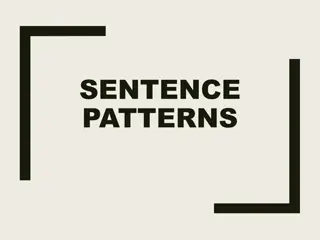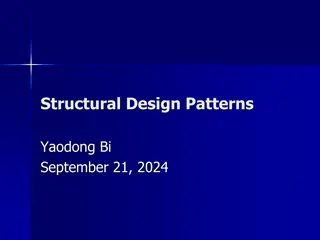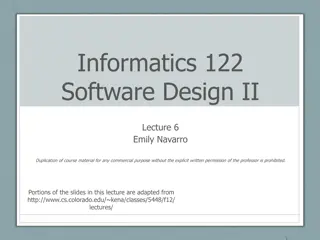Modern Techniques in Apparel Designing and Pattern Development by Mrs. Sonia Khanna
Mrs. Sonia Khanna, an Associate Professor in Home Science, discusses the art of apparel designing and modern pattern development techniques, emphasizing the importance of elements and principles of design in creating garments. The content covers aspects such as structure, functionality, and decoration in garment design, along with insights into the elements of art like line, form, shape, space, texture, and color.
Download Presentation

Please find below an Image/Link to download the presentation.
The content on the website is provided AS IS for your information and personal use only. It may not be sold, licensed, or shared on other websites without obtaining consent from the author. Download presentation by click this link. If you encounter any issues during the download, it is possible that the publisher has removed the file from their server.
E N D
Presentation Transcript
Apparel designing and modern pattern development techniques Prepared by, Mrs. Sonia Khanna Associate Professor, Home science Department, Guru Nanak Girls P.G College, Kanpur (U.P)
APPAREL DESIGNING It is an art of applying design, aesthetics, clothing construction and natural beauty to clothing. Apparel Designing is a technical term pertaining to the specific act of creating clothing. Set of basic skills required for apparel industry are: Designing Developing a pattern Constructing / Stitching and finishing a garment
Designing Garments should be designed considering 3 major aspects: Structure Functional Decoration (Decoratively appropriate to the garment and the wearer) (Garment designed should be structurally effective for the wearer) (Functionally it should permit the activity a person performs wearing it) For designing it is important to have good knowledge of elements and principles of design / art.
Elements of Art In creating a design one of the components which interact is the Art Elements. (The elements and principles of design are flexible and should be interpreted within the context of current fashion. A design can be defined as an arrangement of lines, shape, colours and texture, that create a visual image. The principles of design are the rates that governs how elements are combined. The elements are therefore the raw materials that must be combined successfully. The following are the different/Elements of Art.) Line Form Shape Space Texture Colour These elements are considered as Plastics in art language because they can be manipulated or arranged by the designer to create a desired illusion.
Line It provides the visual dimensions of length and width. When lines combine, space is enclosed and forms and shapes are defined. Lines offered a path of vision for the eyes when is wearing an object/outfit. The arrangement of lines in clothing design can cause to appear heavier or thinner than what actually is. Horizontal line Vertical line Diagonal line Curved line etc. Lines within a garment are created by darts seams and decorative details. Each kind of line produces its own special effect. Straight lines and shapes denote force and strength and have masculine quality; curved lines are the lines of nature, they are graceful and gives a feminine effect. Lines are the greatest devices of fashion designers. Since lines create illusion of height and width, they can be used to one's requirement to tone down or exaggerate a particular figure type.
Vertical Lines : These produce an illusion of added height to the outfit design by adding and contrasting coloured vertical band in the centre or a centre panel added with vertical line gives an added height to the outfit. These lines tend to make a short person looks tall. Horizontal Lines: These lines add width to the garment and decrease the apparent height, for example a wide contrasting coloured belt shortens the height of the figure by cutting the garment into two segments, however the belt has the effect of slimming the waist line, the self- coloured will not shorten the height of the outfit as well as the wearer. Diagonal Lines: These lines can add or decrease the height of the wearer depending on their slope. Long uninterrupted diagonals tilting almost vertically are the most lengthening and most dramatic of all lines. Diagonal lines should be combined with vertical or horizontal lines. If they are used alone for the entire dress the effect will be disturbing. Curved Lines: These lines are more romantic and pensive by nature. Curved lines can be a full circle or may even appear almost straight. Curved lines are considered graceful and feminine, those in a diagonal direction are the most graceful and can be seen in the soft folds of material in a draped dress or a ruffled collar.
Form It is an object having three dimensions like length, width and depth. The human body is a form and by viewing it analytically, its various perspectives are revealed. The human form changes visually with clothing, especially as fashion changes. Shapes Shapes in apparel design means silhouettes. The silhouette of a garment refers to the outline shape that it gives to the wearer. Silhouette is determined by the texture of the fabric and the cut of the garment, the length and width of the garment, Position of waistline length of the shoulder seam etc. A silhouette may be classified as: Tubular Normal A-line Bell Clinging Bouffant, etc.
The basic features of a tubular silhouette is a narrow skirt. A line silhouette is produced by a skirt with a slight flare at the hemline of the garment and it is joined in the sides from the armhole to the bottom hemline without giving the suppression shape at the waist. The bell silhouette is full skirted. Fullness may be in the form of gathers, pleats or flare. Bell silhouette is classified into two types as: Medium bell silhouette Extreme bell silhouette. This extreme bell silhouette is referred as bouffant silhouette. Stiff fabrics like organdie, taffeta, denim produce bouffant effects, because these fabric stands well rather than draping (less fall). Every fashion period, a shape emerges slowly or evolved suddenly, whatever it is, every period has a specific shape of garment which once determined can be modified and re-styled for variation in design without changing the basic shape of the garment, it is either flare or tight, circular or straight, a line or raglan. It has been observed that an easy fitting shape of the garment is easily accepted and largely variated as well as has a longevity of stay, where as a tight fitting garment is generally short lived since it is suitable to only perfect figure types. It is therefore advisable that the designer chooses an easy silhouette to keep on creating for a longer duration.
Space It is generally considered to be the area seen between the shapes. Busy space in clothing becomes distractive and fatiguing to view where an interesting space may go unnoticed or appear monotonous. Colour and Texture When we talk of principles of designing, or when we start off with a given design theme the first thing to occur to our minds is the colour and texture of the fabric. Every season or now and then a colour emerges in the fashion scene which is decided by the leading manufacturers, exporters and textile experts of the fashion world. It is advisable to the amateur to work on the colour in vogue; and to add to its creativity, collaborate with a textile designer and develop a new dimension to the existing patterns. To co-ordinate with an idea of creation will be infinite. Also while choosing a colour one must be utmost careful as colour creates the first impression and hence can glorify or destroy one's appearance. Even a simple silhouette may be enhanced by using effective colour schemes. As texture is the feel, drape and degree of stiffness and softness of the fabric, it also creates a visual effect upon the wearer, given a small swatch of fabric, the designer can visualize the texture and the fall of the fabric which helps him to design further.
Textures Colour Schemes
Principles of Design The principles of design are useful in creating different forms of expression in an artistic manner, which are pleasing and attractive to the eye. Following are the principles of designing. Balance Emphasis Harmony Proportion Rhythm
Balance In clothing balance refers to a visual attribution of weight, from a central area. Balance implies a sense of equilibrium. Pleasing balance brings about a satisfying relationship among all design parts to produce visual harmony. In clothing designs, two kinds of balance are observed. Formal Balance: Formal Balance occurs when object appears to equalise each other by repetition and arranged at equi-distance from the centre. The upper and lower portions of the design are so arranged, as to give an effect of balance. Thus there should not be the effect of too much of weight at the bottom or a heavy appearance. For example, dark coloured skirt over lighter shade of pants make a short person shorter. Informal Balance: Occurs when objects appear to equalize each other but not through repetition and the arrangement is in a haphazard manner. Here design of different sizes and shapes and of different attractions are arranged. The larger and more attractive designs are kept as far away from the centre. If used correctly, informal designs can be effective in being attractive.
Emphasis Emphasis involves the concentration of interest in the selected area of design with other centre of interest subordinated. Emphasis as such, should not be placed at an area that one wishes to minimize attention drawn on. Designers often create emphasis partially through the careful arrangement of line, texture and colours. It could also be called as focal point. Every design needs some note of interest that catches the eye or attracts the attention on a specific area of the garment. Contrasting colour for example could be used to emphasise an area. A black dress with white collar and cuffs will direct the eye to the face and hands. There can be several centres of interest although one or two will be more dominant than the others and will arrest the attention longer and raw the eye back to it more frequently than lesser centres of interest.
Some methods of lay emphasis could be Grouping of design units. Using contrast of hues. By leading lines. A combination of any of the above. Repeating details such as tucks, gathers, button etc. Unusual shapes and textures. Applied design on a contrast background. The placement of dark spots on a lighter colour background (or) vice versa could emphasis the body part they are placed over. While enhancing the design by concentrating on a focal point the designer must bear in mind the figure and personality of the wearer.
Harmony Harmony otherwise called unity. If the principle of proportion, balance, rhythm and emphasis are applied creatively, the resultant design is said to have the harmony. Unity means that all elements of the design work together to produce a successful visual effects. If anyone of the principles are not applied the resulting design will also lack harmony which means; if the principle of structural/decorative design with balanced proportion and quantitative and qualitative emphasis creating a rhythm of its own, give an outcome of harmony of unity. It is a result or an achievement which every designer should keep in mind while designing or drawing or arranging various elements or design for achieving/creating particular purpose of design. Lack of application of any one principles of design, will result in a design which is not harmonious or not in harmony.
Proportion or Scale Relationship in size between a part and the whole is defined to as proportion. For any design, an artist or a designer should aim for a sense of order of unity or oneness among the principles of design. Proportion includes planning of the basic shape within a design. It may involve the scale of the forms within the design like diversion of space to create attractive space relationship where the variety of shapes, sizes and the general idea of unity of principles of designs are to be expressed. Optical illusion is created by changing partial arrangements to enhance the attractive portion that one wishes to enhance. e.g., puffed in the shoulders or increased width in sleeves etc. Is the principles of design that involves a phasing relationships between all parts of a design with respect to each other. This may include: Planning of the basic shapes Division of spaces for a good relationship Creating an optical illusion that will give an impression of, proportion, when it is not possible to change the basic design.
Rhythm Directs the movements of the eyes as one uses the details of a design. Therefore, a rhythmic pattern needs to be established to give a costume unity. There are no pre-requisite rules for establishing rhythm in a design. Rhythm is most effective when it is experienced in a quiet way. It is the repeated use of lines or shapes to create pattern. Rhythm can be achieved through the combination of lines, shape, colour and texture by the following aspects in designing. By regular repeats of trims, (button etc.) texture, and fabric design and prints. Progression or radiation in sizes of trims, colours textures and fabric designs. Radiation or movement from the central point occurring within structural details such as gathers, folds, tucks, darts etc. Continuous flowing lines such as those in bonds of colours, textures and fabric designs.
Rhythm through Progression Rhythm through Radiation Rhythm through Repetition
Divisions of Designing There are two basic divisions of designing in the field of clothing: Structural designing Decorative designing There are two divisions which are often inseparable. They can be defined in other words as factors influencing the design. Structural Design Includes the all over design of a garment. Its form and shape plus all the details involved in assembling the sections of the garment such as darts, pleats, tucks etc. In apparel, structural design is more important because it is the fundamental component of design. To draw a structural design a form or human croque is not necessary. These designs are done by the designers in the buying house. In this category the designs are drawn on the specification chart where much trimmings are not used. These designs will be simple and well defined about their construction, colour, thread and trimmings to be used. It will not be draped on the form. It will be spreaded so that the pattern master can create a proper sample according to the specifications mentions such as its measurements, its sweepline (Hemline) its neckline and any other type of cuts used.
Decorative Design Here it refers to the design which is drawn by the beginner (learners) as well as the boutique designers. These designs need the basic form or a croque and the designs drawn will be draped over it. It is not produced in bulk so it will have more trimmings, prints, embroidery, buttons (that do not fasten) and tacked on bows. The garment which is designed will be selected by the customer, then it will be stitched and because it is not produced in bulk, it will be very costly, in these designs the fabric, style and colour combinations are described so that one can select the design. In this design category specification charts is not prepared, nor it is stitched for standard measurement. It is the design and outfit is made for an individual costumer.
Pattern Making Pattern making is an art. It is the art of manipulating and shaping a flat piece of fabric to conform to one or more curves of the human figure . Pattern making is a bridge function between design and production. A sketch can be turned into a garment via a pattern which interprets the design in the form of the garment components A pattern is flat while the body is not. The body has height, width and depth. With in this roughly cylindrical framework there are a series of secondary curves and bulges, which are of concern to the pattern maker. Darts are the basis of all pattern making. They convert the flat piece of cloth into a three dimensional form, which fits the bulges of the body. Methods of Pattern Making Pattern making involves three methods- Drafting Draping Flat paper patternmaking
Drafting It involves measurements derived from sizing systems or accurate measurements taken on a person, dress or body form. Measurements for chest, waist, hip and so on, and ease allowances are marked on paper and construction lines are drawn to complete the pattern. Drafting is used to create basic, foundation or design patterns. Terminology used in drafting patterns: Draft A schematic plan made of a garment using the pattern making process before seam allowances are added. The act of making (drafting) a pattern. Grain Term used to describe the yarn direction of a fabric: crossgrain (weft), lengthgrain (warp) or diagonal (bias). Also describes the smooth side of a piece of leather after tanning. Grainline Direction of yarns in a fabric weave: crossgrain (weft), length grain (warp), diagonal (bias). Centre Back Vertical line denoting the centre of the back of a garment. Centre Front Vertical line denoting the centre of the front of a garment. Notches Marks made on patterns to indicate where seams align, where hems are turned and other key matching points that are necessary when constructing a garment.
Drafting Methods The two most commonly used methods of drafting a pattern: Manipulating darts, to move them where ever you want them or change them into attractive shaping seams "Slashing and Spreading" your pattern to add fullness in the sleeve, skirt, or anywhere that you don't want a fitted look.
Draping It involves the draping of a two dimensional piece of fabric around a form, conforming to its shape, creating a three-dimensional fabric pattern. This muslin is transferred to paper to be used as a final pattern. Ease allowances for movement are added to make the garment comfortable to wear. Advantage of draping is that the designer can see the overall design effect of the finished garment on the body form before the garment piece is cut and sewn. However, it is more expensive and time consuming than flat pattern making.
Flat Pattern Making It involves the development of a fitted basic pattern with comfort ease to fit a person or body form. A sloper is the starting point for flat pattern designing. It is a simple pattern that fits the body with just enough ease for movement and comfort (Shoben and Ward). Five basic pattern pieces are used for women's clothing. They include a snug-fitting bodice front and bodice back with darts and a basic neckline, a sleeve and a fitted skirt front and back with darts. However, as fashion changes frequently women's styles fluctuate frequently. These basic slopers are then manipulated to create fashions. A basic sloper has no seam allowances, which facilitates its manipulations to various styles. It has no design interest, only construction lines are marked on it. It is necessary that the basic structure of a sloper should be such that adjustments can be introduced easily. For a good pattern making, accurate measurements are of utmost importance. The flat patternmaking method is widely used in the ready-to-wear market because it is fast and accurate (Aldrich).
Types of Patterns on Paper TYPES OF PATTERNS ON PAPER : There are different types of paper patterns which are Standardised paper pattern Individual paper pattern Block paper pattern Graded paper pattern Commercial paper pattern
Standardised Paper Pattern The standardised paper pattern is prepared using standard body measurements. This will suit a group of people with the specific chest measurements. This method is followed in training and tailoring schools.
Individual Paper Pattern Individual paper patterns are prepared using measurements of a particular per-son. It is done at home and some tailor shops. It is used to produce customized dresses.
Block Paper Pattern Block paper patterns are prepared with thick cardboards of the standardized body measurements. These patterns are mostly used in the garment industry to cut bulk amount of garment in less time. These patterns are stored for further use also.
Graded Paper Pattern Graded paper patterns are prepared of five consecutive sizes (Example : 100, 110, 120, 130, 140 cm measurements) in one single pattern. The required size is traced and cut from this pattern sheet and used. These paper patterns help one to increase or decrease a paper pat-tern. These patterns are very useful for designers.
Commercial Paper Pattern Commercial paper pattern are the ready-made patterns, available in shops for all body measurements. These come with instruction manuals and step by step guidelines about selection of fabric, preparation of fabric, marking, cutting and steps for sewing. Butter paper or tracing papers are used for the preparation of commercial paper patterns. Garment variation is also seen in some com-mercial patterns. The patterns are placed in envelopes with pictures of the garments on models and fabric combination in which the garment will look good.
Pattern making in Today's World Pattern making today has become an easy job with the use of the computers. Now-a-days different softwares are available in the market to meet the needs of the manufacturers. The different softwares used are Gerber, Lectra, Tukatech , OptiTex etc. These softwares have made the job of the Pattern master easier. They have made the process of pattern making more economical and less time consuming. Pattern-making softwares enables you to input your measurements and draft out a pattern. These softwares draft patterns to fit your measurements specifically, eliminating much fitting trial and error in the sewing room. A pattern can be made from a 3D form in just a few steps by using these softwares. An individual's measurements are collected from 3D body scanner. The measurements are used to create a virtual 3D model of the individual's body. The 3D to 2D software allows the user to define a garment surface in relation to the 3D body model. Once the garment surface is defined, the application automatically unwraps and outputs a 2D flat pattern in .dxf format.








